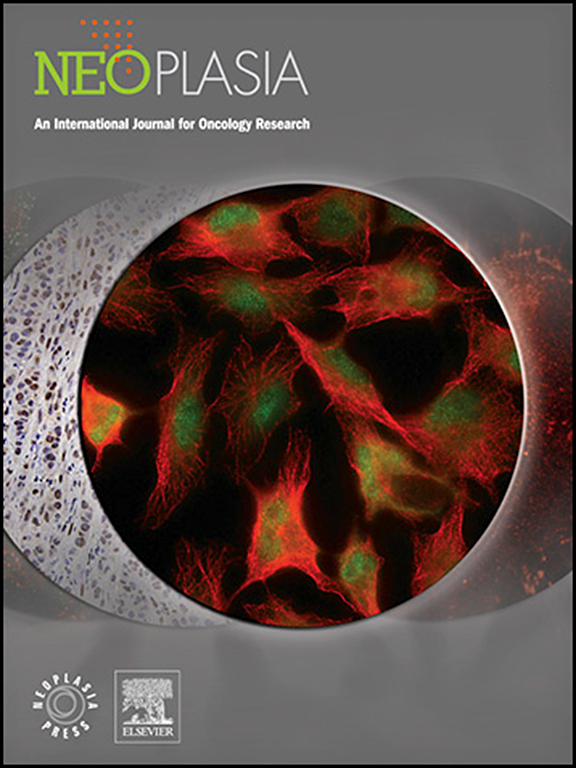Pancreatic cancer cells infiltrate nerves through TGFbeta1-driven perineural epithelial-to-mesenchymal-like transdifferentiation
IF 4.8
2区 医学
Q1 Biochemistry, Genetics and Molecular Biology
引用次数: 0
Abstract
Neural invasion is a prognostic hallmark of pancreatic ductal adenocarcinoma (PDAC), yet the underlying mechanisms behind the disruption of perineural barriers and access of cancer cells into intrapancreatic nerves remain poorly understood. This study aimed to investigate the role of epithelial-mesenchymal transformation (EMT) in perineural epithelial cells during neural invasion.Histopathological analysis of human and murine primary tumors using perineurium-specific GLUT1 antibody revealed a reduction in perineural integrity, which positively correlated with the extent of neural invasion in human PDAC cases. Human pancreatic cancer cell lines were found to secrete TGFbeta1, which induced EMT of perineural epithelial cells, characterized by the loss of epithelial markers (CK19-9) and the acquisition of mesenchymal markers (alphaSMA, N-Cadherin). Additionally, these transitioning perineural epithelial cells demonstrated increased matrix-degrading capabilities through the upregulation of matrix-metalloproteases 3 and 9 via SMAD2. In an autochthonous mouse model with elevated endogenous TGFbeta1 levels in addition to oncogenic Kras activation (Ptf1aCre/+, LSL-KrasG12D/+, LSL-R26Tgfβ/+), decreased perineural integrity could be reproduced in vivo.Collectively, these findings underscore the role played by TGFbeta1-overexpressing pancreatic cancer cells in the dismantling of perineural barriers during neural invasion.

胰腺癌细胞通过tgfbeta1驱动的神经周围上皮样向间质样转分化浸润神经。
神经浸润是胰腺导管腺癌(PDAC)的预后标志,然而神经周围屏障破坏和癌细胞进入胰腺内神经的潜在机制尚不清楚。本研究旨在探讨神经侵袭过程中上皮-间充质转化(epithelial-mesenchymal transformation, EMT)在神经周围上皮细胞中的作用。使用会阴特异性GLUT1抗体对人和鼠原发肿瘤进行组织病理学分析,发现会阴完整性降低,这与人类PDAC病例的神经侵袭程度呈正相关。发现人胰腺癌细胞系分泌TGFbeta1,其诱导神经周围上皮细胞EMT,其特征是上皮标记物(CK19-9)的丢失和间充质标记物(alphaSMA, N-Cadherin)的获得。此外,这些过渡的神经周围上皮细胞通过SMAD2上调基质金属蛋白酶3和9,显示出增强的基质降解能力。在具有内源性TGFbeta1水平升高以及致癌Kras激活(Ptf1aCre/+, LSL-KrasG12D/+, LSL-R26Tgfβ/+)的本地小鼠模型中,可以在体内重现周围神经完整性的降低。总的来说,这些发现强调了tgfbeta1过表达的胰腺癌细胞在神经侵袭过程中拆除神经周围屏障的作用。
本文章由计算机程序翻译,如有差异,请以英文原文为准。
求助全文
约1分钟内获得全文
求助全文
来源期刊

Neoplasia
医学-肿瘤学
CiteScore
9.20
自引率
2.10%
发文量
82
审稿时长
26 days
期刊介绍:
Neoplasia publishes the results of novel investigations in all areas of oncology research. The title Neoplasia was chosen to convey the journal’s breadth, which encompasses the traditional disciplines of cancer research as well as emerging fields and interdisciplinary investigations. Neoplasia is interested in studies describing new molecular and genetic findings relating to the neoplastic phenotype and in laboratory and clinical studies demonstrating creative applications of advances in the basic sciences to risk assessment, prognostic indications, detection, diagnosis, and treatment. In addition to regular Research Reports, Neoplasia also publishes Reviews and Meeting Reports. Neoplasia is committed to ensuring a thorough, fair, and rapid review and publication schedule to further its mission of serving both the scientific and clinical communities by disseminating important data and ideas in cancer research.
 求助内容:
求助内容: 应助结果提醒方式:
应助结果提醒方式:


